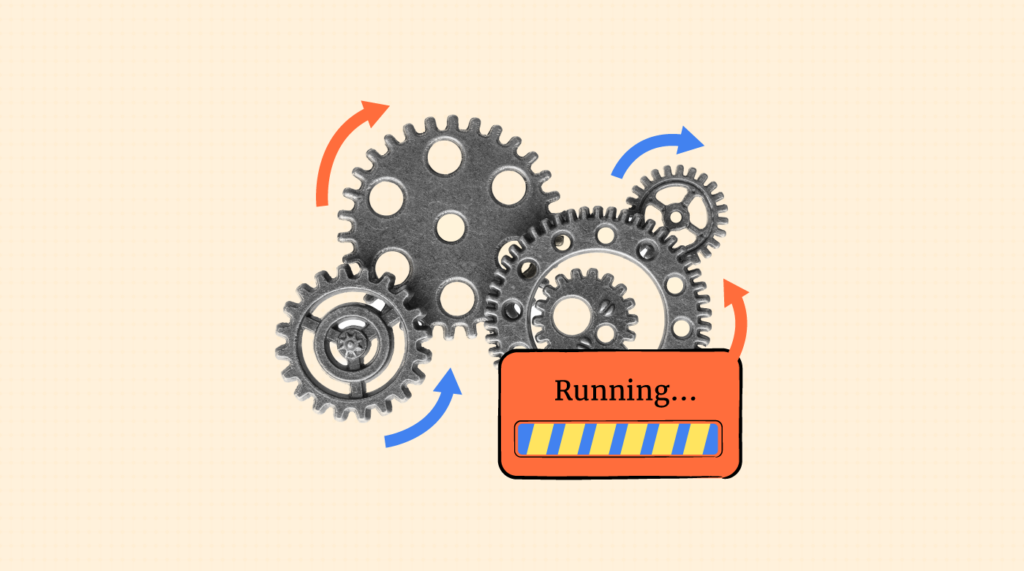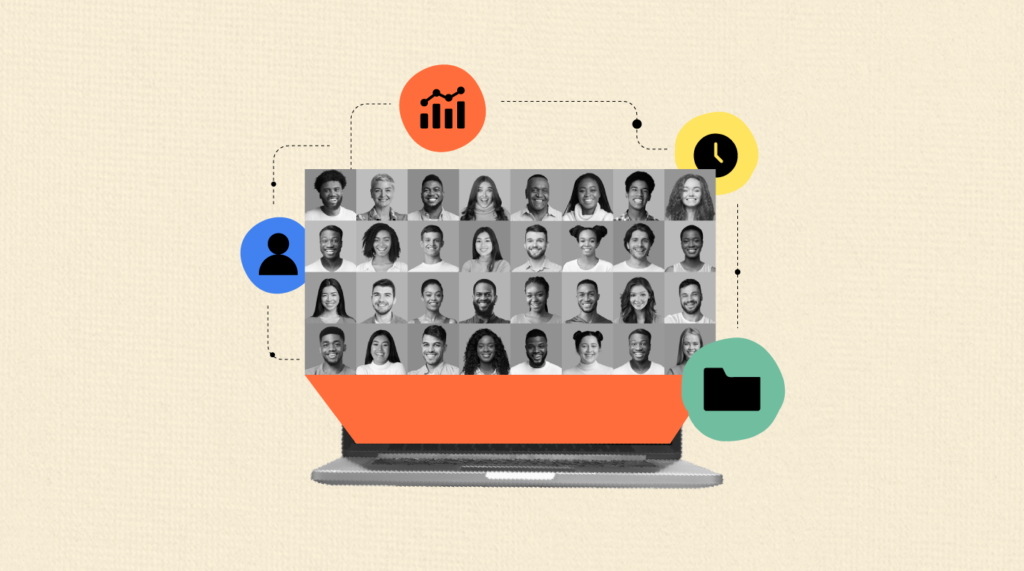Have you ever thought about the intricacies behind the different HR processes in an organization?
It's like a complex dance where all steps must synchronize perfectly, and that's where HR systems integration comes into play.
What Is HR Systems Integration?
HR systems integration means connecting different HR software and systems, allowing them to communicate with each other and function harmoniously. Imagine a series of interconnected cogs in a massive machine. When one cog turns, the others follow suit.
The Benefits Of Integrating HR Systems
In today's digital age, it's never been easier to connect systems across your organization and let data flow where it needs to. And an integrated HR system is increasingly important as new trends emerge in HR tech.
As the number of tools used by HR departments continues to rise (and new HR software products are always cropping up), the cost and headaches associated with disparate systems also grows.
Here are some benefits you can expect when you have integrated HR solutions:
Streamlined Processes

Integrated software systems makes for more streamlined processes and automated workflows.
For example: You might connect your time tracking solution with your payroll software, ensuring employee pay checks are accurate to their logged hours. By syncing up your various HR applications, you alleviate time consuming manual work.
Enhanced Data Accuracy

When information is added, removed, or altered in one system, the updates can be made available elsewhere, removing the need for HR professionals to manually update information across multiple programs.
This helps you ensure that HR data such as employee information remains up to date and well-governed, and reduces the risk of human error. It's beneficial both to your HR team and your IT team—it’s a win-win.
Data integration can also help you create a single source of truth in any one of your systems. For example, you might opt for your human resource management system (HRMS) or your human capital management (HCM) platform to be the dedicated place where you know employee data is accurate. As your HR function scales, this is particularly helpful.
Improved Employee Experience

With all your apps well-connected, existing employees, new hires, and those going through your recruitment process will also benefit from more efficient processes and improvements made off the back of data analysis.
For example, once someone accepts a job offer, their details are transferred from your ATS into your onboarding software tool and/or human resource information system (HRIS). New staff won’t need to re-enter their information into separate systems, reducing the tedious paperwork of onboarding and supporting your talent management efforts.
HR Systems Integration Examples
Integrating various Human Resources (HR) systems is crucial for streamlining processes, improving data accuracy, and enhancing employee experience.
Here are some practical examples of how HR systems can be integrated to achieve these goals:
Integration of Applicant Tracking System (ATS) with Onboarding Software
This integration allows for a seamless transition of candidate data from the recruitment phase to the onboarding process.
Benefits: Reduces manual data entry, minimizes errors, and ensures a smooth start for new employees.
ATS Options to Consider:
 | Greenhouse is a popular applicant tracking system that integrates with over 400 other apps. Integrations include onboarding tools like Deel, Justworks, Rippling, UKG, and others. |
 | Trakstar offers both an ATS solution and performance and learning management tools. This allows for streamlined integration from hiring through onboarding and performance management. |
Onboarding Software to Consider:
 | Deel provides a comprehensive set of onboarding features as part of its employer of record (EOR) offer. It has plenty of native integrations as well as an API for building custom connectors. |
 | ClearCompany provides a well-rounded suite of features such as employee onboarding tools. It integrates with tools for background checks, skill assessments, payroll, benefits, and more. |
Payroll System Integration with Time and Attendance Tracking
By integrating the payroll software with time and attendance software, employee hours, leaves, and absences are directly fed into the payroll system, facilitating accurate and efficient payroll processing.
Benefits: Integrated payroll systems ensure accurate pay calculations, compliance with labor laws, and saves time in payroll processing.
Payroll Systems to Consider:
 | Paycor has automation features to streamline your payroll process. It provides several additional functionalities including time tracking, making it a solid option for integrated systems. |
 | Paycheck Flex is an integrated payroll and time management solution. You can use it to track employee hours and manage time off requests as well as run your payroll and benefits administration. |
Time Tracking Tools to Consider:
 | Connecteam is an HR tool that combines time tracking and scheduling with task management and team communication tools. It integrates with QuickBooks Payroll and other payroll tools. |
 | TimeClock Plus is a time and attendance tracking software that's highly configurable to your needs. It integrates with over a hundred payroll solutions like ADP, Quickbooks, Paychex, and more. |
Employee Engagement Tools Integrated with HR Analytics
Combining employee engagement tools with HR analytics platforms enables the analysis of employee sentiment and engagement levels in relation to HR metrics.
Benefits: Offers insights into the impact of HR initiatives on employee morale, helps in making data-driven decisions to improve workplace culture, and tracks the effectiveness of engagement strategies.
Employee Engagement Software to Consider:
 | Lattice provides employee engagement tools like performance and goal tracking. It has built-in analytics and integrates with BambooHR, Personio, Gusto, and other HR tools. |
 | Workleap Officevibe offers pulse surveys, anonymous feedback, 1-on-1s, and recognition tools. Its digestible analytics reports help you track trends in employee engagement over time. |
HR Analytics Tools to Consider:
 | Trinet is a robust HR system that offers analytics on your headcount, turnover, absenteeism, benefits utilization, and more. It can be used to track various data points and run in-depth analyses. |
 | Insperity provides real-time data analytics, benchmarking tools, and custom reporting features to help you monitor your HR function. You can build custom integrations with its API. |
Performance Management System Integrated with Learning Management System (LMS)
Linking how you track performance management with your LMS enables automatic suggestions for training and development based on performance reviews and assessments.
Benefits: Supports personalized employee development plans, encourages continuous learning, and aligns training initiatives with performance goals.
Performance Management Software to Consider:
 | As mentioned, Trakstar combines performance and learning management with its ATS, making it a fully integrated solution for hiring, training, and retaining top talent. |
 | Deel is another good option for performance management should you wish to offload the task to an ERP provider. It has lots of integrations, plus an API for building custom connectors. |
Learning Management Systems to Consider:
 | iSpring Learn is a popular LMS platform that's highly customizable for various use cases. It integrates with several other tools and a REST/SOAP API is available to build custom integrations. |
 | Absorb LMS provides AI-powered learning management tools that helps you anticipate employee training needs. It integrates with ADP, BambooHR, ClearCompany, and other HR tools. |
Steps To Achieve Successful HR Systems Integration
1. Scoping
Just as a chef needs to know the ingredients before cooking, first review the systems you have in place and ask yourself which would benefit from being integrated and what your options are for achieving that.
Perhaps the vendors you’ve chosen already have integrations set up, or, if not, you could ask them to put it in their product roadmap. Note this might incur a monthly cost or one-time setup fee.
If the juice is really worth the squeeze, you could consider building an API to connect two disparate applications.
Alternatively, you might consider purchasing a new piece of HR software with multi-functionality and thus avoid having to integrate systems created by two different vendors.
Some questions to ask here:
- What do you want it (the new system) to do?
- What might you want it to be able to do in 5 years?
- How organized is your HR department and company as a whole with their current data management?
- How much buy-in can HR get from the other departments?
- Are the expectations for visible ROI managed appropriately with all stakeholders?
2. Implementation
Once you’ve decided which applications you’d like to integrate, or which new piece of software you’d like to introduce, then it’s going through whichever steps are necessary to implement the integrations or purchase and set up the new software.
This will likely be a between various stakeholders, including the vendors themselves, so prepare to get your project management hat on and manage some stakeholders and timelines.
3. Maintenance
Depending on the complexity of your system, it might require a little maintenance from time to time.
This will likely be undertaken vendor side, but may require some internal resource if you go down the custom API route.
Hopefully, everything goes smoothly and your new integrated HR system delivers on its promises.
Using Automation to Boost HR Processes
Automation plays a pivotal role in enhancing efficiency, accuracy, and employee experience.
By integrating HR systems, organizations can streamline various basic HR functions.
1. Payroll Processing
Automating payroll systems can handle complex calculations, tax withholdings, and pay distributions with minimal human intervention.
Benefits
- Reduces the likelihood of errors
- Saves time
- Ensures compliance with tax laws and regulations
- Generate detailed reports for better financial planning and auditing.
2. Workforce Management
Automated tools can assist in scheduling, time tracking, and managing employee availability, especially in businesses with large or shift-based workforces.
Benefits
- Improves accuracy in attendance tracking
- Optimizes staffing levels
- Enhances the overall management of labor costs
- Provides real-time data to make informed decisions about workforce allocation.
3. Applicant Tracking System (ATS)
An ATS automates the process of tracking and managing job applicants and streamlines the recruitment process from job posting to hiring.
Benefits
- Reduces time-to-hire
- Improves candidate experience
- Helps in maintaining a talent pool for future vacancies
- Ensures a fair and unbiased recruitment process by standardizing criteria for candidate screening.
4. Learning Management System (LMS)
A LMS automates the delivery, tracking, and reporting of training programs and e-learning courses.
Benefits
- Enables personalized learning paths
- Tracks employee training progress
- Measures the effectiveness of training programs
- Facilitate continuous employee development and skill upgrading.
5. Performance Management
Automated performance management systems streamline the process of setting goals, providing feedback, and conducting evaluations.
Benefits
- Ensure regular and unbiased performance assessments
- Foster ongoing communication between managers and employees
- Facilitate data-driven decisions regarding promotions, raises, and professional development.
6. Employee Self-Service Portals
These portals allow employees to manage their personal information, benefits, and other HR-related tasks independently.
Benefits
- Empowers employees
- Reduces the administrative burden on HR professionals, leading to increased efficiency and employee satisfaction.
7. HR Analytics
Automated HR analytics tools can gather and analyze data on various aspects of employee performance and engagement.
Benefits
- Provides valuable insights for strategic decision-making
- Helps identify trends and patterns
- Supports the optimization of HR strategies and practices.
Key Challenges with HR Integration
Doesn't HR systems integration sound great? Well, don't get ahead of yourself. The goal of making all these systems communicate and share data isn't without it's hurdles. Let's take a look at a few.
1. Compatibility Issues
Different HR systems may have varying data formats, platforms, and standards, leading to compatibility issues when integrating.
This can result in data silos, where information is trapped in one system and inaccessible to others, hindering the seamless flow of HR data across platforms.
2. Data Security and Privacy Concerns
Integrating multiple systems escalates the complexity of data security, as each system may have different security protocols.
As a result, ensuring the security and privacy of sensitive employee data across interconnected systems becomes a more complex and critical task, requiring stringent security measures.
3. Cost and Resource Allocation
The process of integrating various HR systems can be costly and resource-intensive, especially for large organizations or those with outdated legacy systems.
Organizations may face challenges in allocating the necessary budget and IT resources, potentially leading to delays or suboptimal implementation.
4. User Adoption and Training
Employees and HR staff may resist adopting new systems due to comfort with existing processes or apprehension towards new technology.
This resistance can slow down or hinder the effective use of integrated systems, necessitating comprehensive training and change management strategies.
5. Ongoing Maintenance and Updates
Integrated systems require continuous maintenance and regular updates to ensure optimal performance and security.
This demands ongoing attention and resources, and failure to keep systems updated can lead to operational issues or security vulnerabilities.
Frequently Asked Questions
What are the primary benefits of HR systems integration?
Streamlined processes, enhanced data accuracy, and an improved employee experience are some of the top benefits.
How can I ensure data security when integrating systems?
Invest in robust security measures, conduct regular audits, and prioritize systems with a strong reputation for data protection.
Can all HR systems be integrated?
While most can, some might have compatibility issues. It’s essential to conduct thorough research before integrating.
How long does the integration process typically take?
It varies based on the systems involved and the company’s size. However, with the right planning, the process can be efficient.
Are there costs involved in integrating HR systems?
Yes, there might be initial costs for the integration tools or services, but the long-term benefits often outweigh these costs.
Harnessing the Power of HR Systems Integration
The integration of HR systems is no small task. There is a lot at stake when it comes to operational efficiency and good data practices. But done right, it can create a better employee experience and a far more efficient working experience for your HR team.
Key takeaways
1. Streamlined Processes and Enhanced Data Accuracy
The integration of HR systems leads to significantly streamlined processes. This integration ensures that data is consistent, accurate, and updated across all platforms, eliminating the need for manual updates and reducing the risk of errors.
2. Improved Employee Experience and Operational Efficiency
These systems facilitate personalized learning paths, unbiased performance assessments, and empower employees through self-service portals, contributing to a more engaged and satisfied workforce.
3. Navigating Integration Challenges
Compatibility issues between different systems, data security, budget, resources, user adoption and training, and ongoing maintenance are significant challenges.
Want to stay up to date on all the latest developments around HR systems and technology? Subscribe to our newsletter and you'll receive all the latest content about HR and people operations straight to your inbox!


